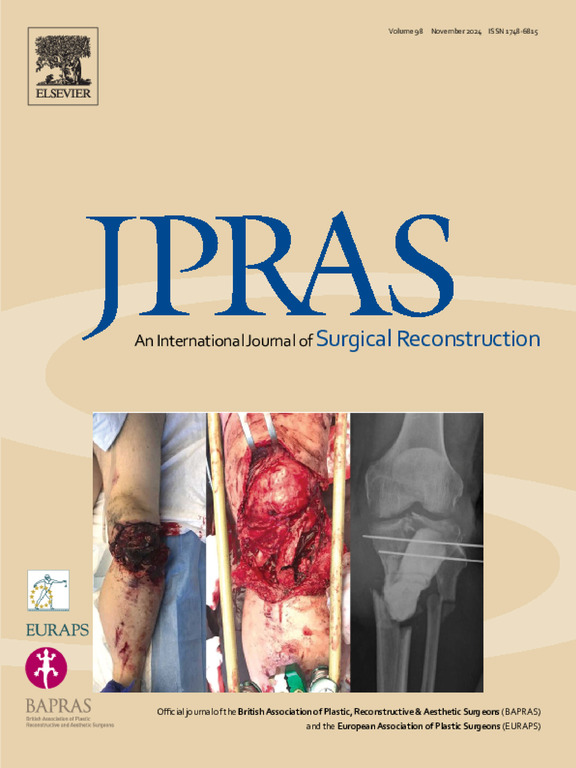DIEP和PAP游离皮瓣用于乳腺癌乳房重建的比较:一项超过10年的677例患者的回顾性研究。
IF 2
3区 医学
Q2 SURGERY
Journal of Plastic Reconstructive and Aesthetic Surgery
Pub Date : 2025-02-01
DOI:10.1016/j.bjps.2024.11.040
引用次数: 0
摘要
背景:肿瘤手术后的深动脉穿支(PAP)皮瓣已成为乳房重建的一种相关选择,但主要用于不能进行上腹部深下穿支(DIEP)皮瓣的病例。本研究的目的是比较PAP和DIEP皮瓣在乳房重建中的手术和美学效果。方法:纳入2012年1月至2020年12月在法国巴黎蓬皮杜欧洲大学医院整形外科行DIEP或PAP皮瓣乳房重建术的女性。记录患者的人口学特征、类型、侧位和重建时间。比较手术时间、住院时间、一般并发症和手术并发症。我们还比较了晚期再手术的次数、相对于初始重建手术的时间以及手术的目的。结果:共纳入677例患者,其中559例行DIEP皮瓣,118例行PAP皮瓣。PAP皮瓣患者比DIEP患者更年轻、更瘦、初始罩杯尺寸更小(p < 0.001),两组手术时间相似(p = 0.074)。在DIEP和PAP之间,术后早期再手术次数(p > 0.554)和后期翻修次数(p > 0.403)没有差异。结论:在技术和人力条件允许的情况下,PAP皮瓣是一种有效的技术,不会增加手术并发症和再手术的风险,也不会延长手术时间。PAP瓣应被视为主要的治疗选择,而不是作为DIEP瓣的替代。本文章由计算机程序翻译,如有差异,请以英文原文为准。
Comparison of DIEP and PAP free flaps for breast reconstruction in the context of breast cancer: A retrospective study of 677 patients over 10 years
Background
Profunda artery perforator (PAP) flap following cancer surgery has emerged as a relevant alternative for breast reconstruction but is mainly used in cases where the deep inferior epigastric perforator (DIEP) flap cannot be performed. The aim of this study was to compare the PAP and DIEP flaps’ surgical and aesthetics outcomes in breast reconstruction.
Methods
Women who underwent breast reconstruction by DIEP or PAP flap at the Plastic Surgery Department of Georges Pompidou European University Hospital, Paris, France, between January 2012 and December 2020 were included. Patient’s demographic characteristics, type, laterality, and timing of reconstruction were recorded. Operative times, length of hospital stay, general complications, and surgical complications were compared. The number of late surgical reoperations, their timing relative to the initial reconstructive procedure, and their purpose were also compared.
Results
A total of 677 patients were included, 559 of whom received DIEP flaps and 118 received PAP flaps. PAP flap patients were significantly younger, thinner, and had a smaller initial bra cup size than those who received DIEP (p < 0.001) Operative time was similar for both groups (p = 0.074). There was no difference in the number of early post-operative reoperations (p > 0.554) or late revisions (p > 0.403) between DIEP or PAP.
Conclusion
Provided that the technical and human resources are available, PAP flap is a valid technique, without increased risk of surgical complications and reoperations, or lengthening of operative time. The PAP flap should be considered a primary therapeutic option and not as an alternative to the DIEP flap.
求助全文
通过发布文献求助,成功后即可免费获取论文全文。
去求助
来源期刊
CiteScore
3.10
自引率
11.10%
发文量
578
审稿时长
3.5 months
期刊介绍:
JPRAS An International Journal of Surgical Reconstruction is one of the world''s leading international journals, covering all the reconstructive and aesthetic aspects of plastic surgery.
The journal presents the latest surgical procedures with audit and outcome studies of new and established techniques in plastic surgery including: cleft lip and palate and other heads and neck surgery, hand surgery, lower limb trauma, burns, skin cancer, breast surgery and aesthetic surgery.

 求助内容:
求助内容: 应助结果提醒方式:
应助结果提醒方式:


